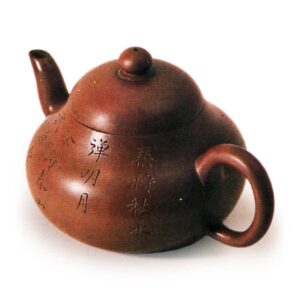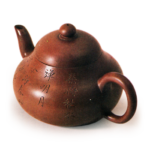
Kibisho (kyuyaki) is a small vessel used for brewing tea.
It is jar-shaped and equipped with a lid, spout, and handle. In ancient times, metal objects were used, but in later times stoneware, pottery, and porcelain were used exclusively, and are still in use today. The most widely used type today is the kyusu (kyusu), but all of the words on the left refer to kyubisho. Chatsubo (“Chasan”, “Chaso”, “Yanggang Meito-roku”, “Shinzai Seijiroku”), Myogi-tsubo (“Ma-jyo-e idoki”), Chabin (“Kaisen”, “Sencha shiyou-shu”, “Seifu-gon”, “Geien-nichi-shou”), Myogi-tsubo (“Shikyoroku”), Chanposho (“Ryosando-chawan”), Chashuhyo (“Chaso”), Chanbyo (“Sencha shiki”), Myogi-tsuki (“Sencha shiki”), Chameng (“Sencha shiki”), Sandkan (Ruisho Compendium, Sencha Shiki), Yixing kan (Yang Jiang Mei Zoroku, Kankodo Zoroku), kyuyaki (“Sencha Shiki”, “Kankodo Zoroku”), kyuyaki (“Geien Nissho”, “Honcho Pottery No Tersei”), kyuuoyaki (“Ishiyama-Sai Chagu Zufu”), kyuhasei (“Temporary Guest Reception”), kyuko (“Morisada Komasu Manuscript”), kyuhatsu (“Shinoosha Uta-shu”), and kyusu (“Sencha Shiki”). Shiki”). The Edo period literature indicates that the character for chabin was initially applied, but it is unclear how this was read. The term “kibisho” was used exclusively from the end of the Edo period onward, and when “Geien Nissho” (Geien Nichi-sho) stated that kyubiyaki was kyusu, “Ryozando Chawanwa” (Ryozando Tea Story) and “Taisanshi” (Other Mountain Stories) added the character for kyusu in Ming Dynasty’s “Sanyoukubu” to that theory and proposed that the term “kyusu” was used for a long time. In the late Meiji period (1868-1912), however, it became clear from linguistic studies that Kyusu was a variant of Kibisho, and that Kibisho was similar to Taiwanese Kipsio or Southern Kibishu, which were both varieties of the Chinese sound. See the articles by Ogawa Naoyoshi, Yamada Takao, and Yamanaka Sho in the January and April issues of the Journal of the Tokyo Anthropological Association in 1911.
The origin of ceramic kibisho in China is said to date back to the Ming Dynasty (1573-1620), when it was first made by a monk at Jinsha Temple in Yixing. According to one theory, the kibisho was not made until the time of Ishikawa Jozan, who is said to be the founder of the sencha ceremony, but many date it to 1756 or later, citing “Kofuyo kibisho was found in Horeki 6 (1573-1620), and a wooden seal was put on it by Taiga-do. However, the fact that there is an illustration of a Chinese-made kibisho in the “Biography of Early Modern Males” (vol. 2) shows that it was in use before 1756 (when he was already 82 years old). In the “Sencha Shitsu (Tea Ceremony Book)” published in 1756, there is an article about boiling tea in a porcelain kibisho. The fact that this practice was not widely practiced, however, can be seen, for example, from a comical story in the sixth volume of “Tokaido Chu Hizakurige” published in 1807, in which Kitahachi mistook a kyusu (teapot) used by a hermit on a riverboat on the Yodo River for a kyubin (urine bottle).
The kibisho was first used exclusively over an open fire, as shown in the illustration of the tea utensils of the tea master Sell Cha-Ou.
The use of the kibisho is also attested to in articles such as “Sencha Shoyo Shu,” “Seifu Tsuyogen,” “Temporary Guest Reception,” “Morisada Manzoku,” and “Tadasan Shishi.
The name “konrokibisho” was also used to refer to the portable tea stove, as it was used on the stove top, as seen in “Sankai Santai Shishi” and “Minmichuan”. This konro kibisho had a straight handle that extended out to the side (yokote), but during the tea boom of the Kasei period (1804-30), the dashi kibisho, which had a curved handle and was used exclusively for brewing tea, came into use. The traditional konro kibisho was called yuwakashi, and only the dashi kibisho was called simply kibisho. Later, however, a new type of konrokibisho was developed that was used to make tea without an open flame, and the distinction between konrokibisho and dashi kibisho was no longer necessary.
Kibisho production is said to have been started by Sanjiya Shichibei (Sanshichi) near Kenninji Temple in Kyoto and Umebayashi Kinzo in Kiyomizu during the reign of Sachaon, the founder of the tea ceremony during the Horeki era (1751-64). It is also said that at the beginning of the Kansei era (1789-1801), Murase Koratei, Ueda Akinari, and others took steps to have Shimizu Rokubei create the tea ceremony. The “Sencha Brief Account” and the “Tokoaka Tsukuyu Roku” (A Brief Account of Sencha Tea) describe Rokubei as being extremely skillful in the art. Later, as the tea ceremony flourished, Kibei (Sahei), Kasuke, Yosanbei, and Shuheira became famous and their works were highly valued by the public. According to “Kochoku Aka Gosotsu Roku” and “Mimitoshigawa,” the kibisho made by Akinari Ueda was very popular, and Awata-yaki’s kibisho is based on this creation. The most famous kibisho potter outside of Kyoto was Mori Yusetsu of Banko-yaki during the Tempo period (1830-44), who was the first to invent the kyusu mold making method in Japan. Kibisho of Banko-yaki later established a low-cost production method using special lantern molds, and his sales channels expanded, and he continued to do so throughout the Meiji period (1868-1912). Sugie Jumon of Tokoname began making white and vermilion mud kyusu at the beginning of the Ansei period (1854-60), and in 1878 (Meiji 11), under the instruction of Kaneko Tsune, a Kiyonin, he made the first Yixing-style vermilion mud kyusu in Japan. According to “A Brief History of Sencha”, “Chinese kyusu ware is the best, but there are good and bad among them, the best among them being a kyusu ware of the pumpkin shape (Chinese) owned by Takao, modeled after Shimizu Rokubei. In addition, there are Korean, Namban, and Hirokuchi forms, which have their own sources and are to be regarded as temporary.
Tama’s “Myogau jar catalogue” says, “There is no single shape. Or a circle, or a direction, or a ridge, or a wide mouth, etc. Or a ridge, or a genus. Or flat, or straight. Or flat, or straight; or sublime, or lowly; or large, or small. Or large, or small. But what is like a protein cannot help but be a circle.
Like a egg, it cannot be round. What is like a touch cannot help but be a ridge. Like a drum, it cannot be a stem without a stem. Like the “∗”, it cannot be flat.
The following more than 20 styles are listed: koen, hishika, narcissus, tokoshi, hana-gumi, and eluan. As you can see, there are a wide variety of kibisho shapes, but the key to the kibisho lies in its capacity, lid, spout, and handle. Recently, porcelain and ceramics have been used exclusively, but stoneware is better. Yixing tea pots are stoneware wares without glaze, and are called vermilion mud, purple mud, white mud, oolong mud, yellow mud, pear-skin mud, and pine and flower mud according to their clay color. In Japan, Tokoname and Sado Island’s Tsuneyama red mud are well known, but both were developed after the Meiji period (1868-1912). Yixing tea pots are also marked with poems, ancient words, family names, and other inscriptions such as “bye,” “hall,” “pavilion,” “sai,” and “pavilion. Finally, the term “kibisho” is used in the modern sencha ceremony to refer to a konro kibisho. The back-handled ones (some are horizontal) are called kyusu, and are made of stoneware, pottery, porcelain, etc. They are used for brewing tea and are small in size. (They are used for brewing tea and are small in size.)








